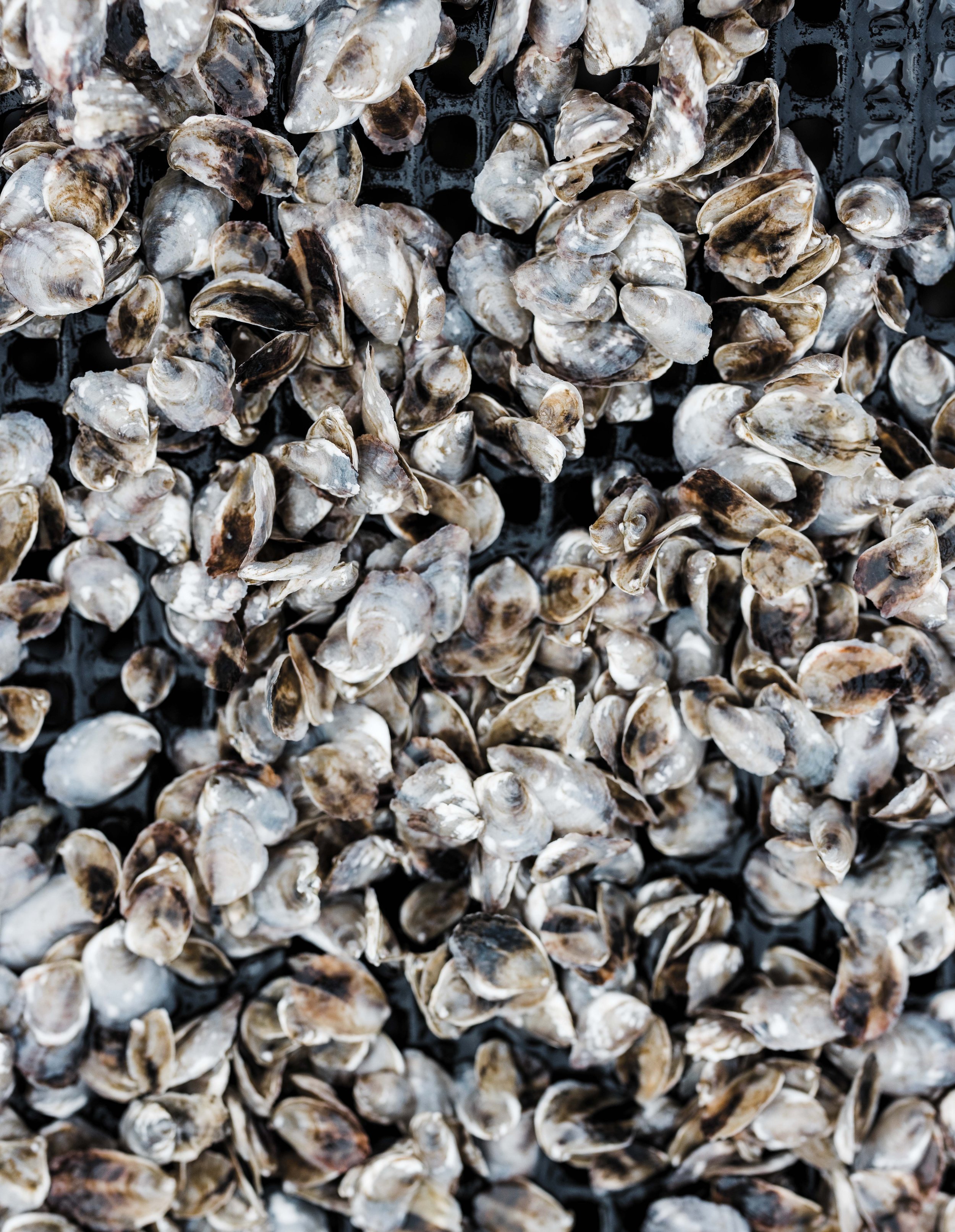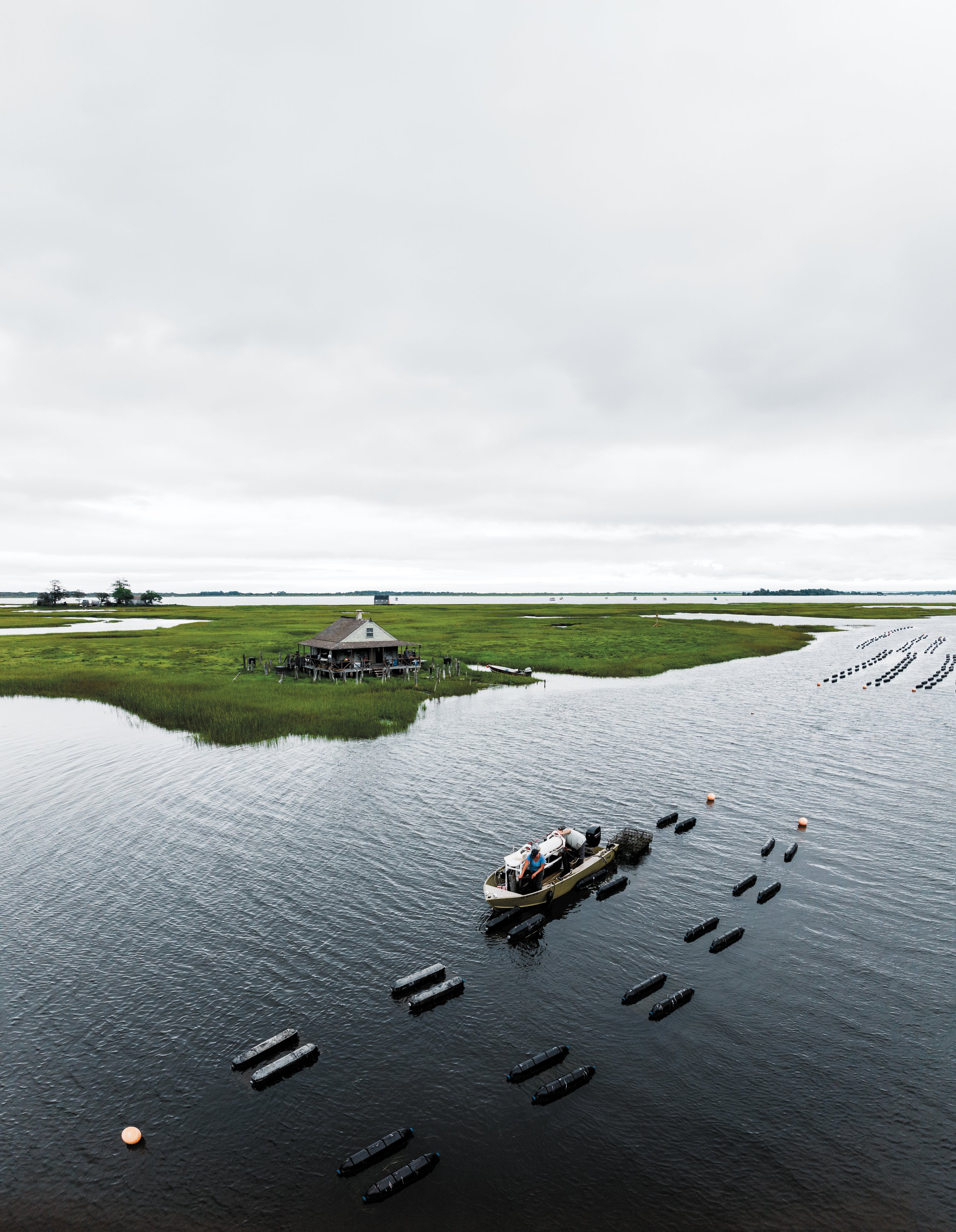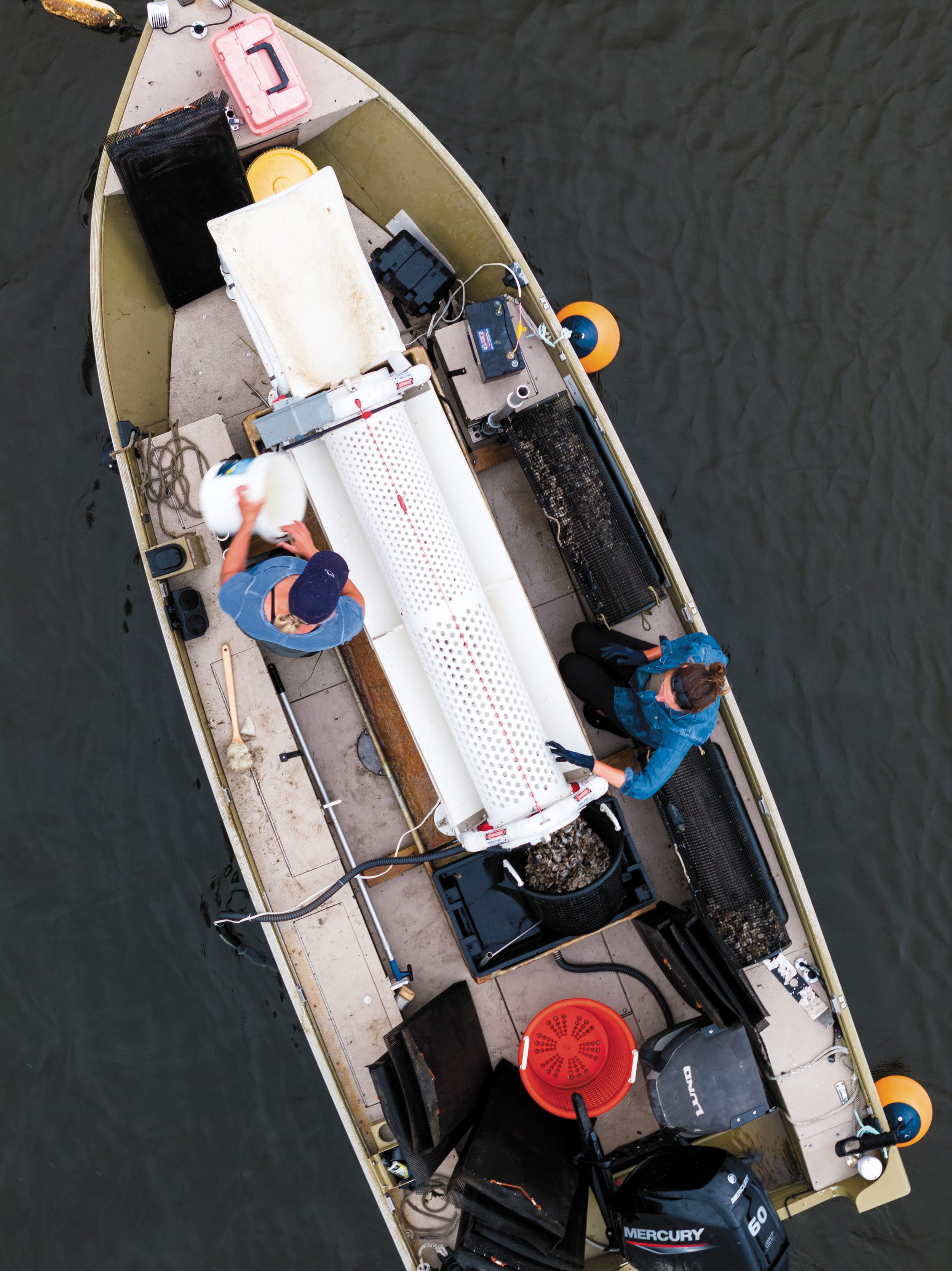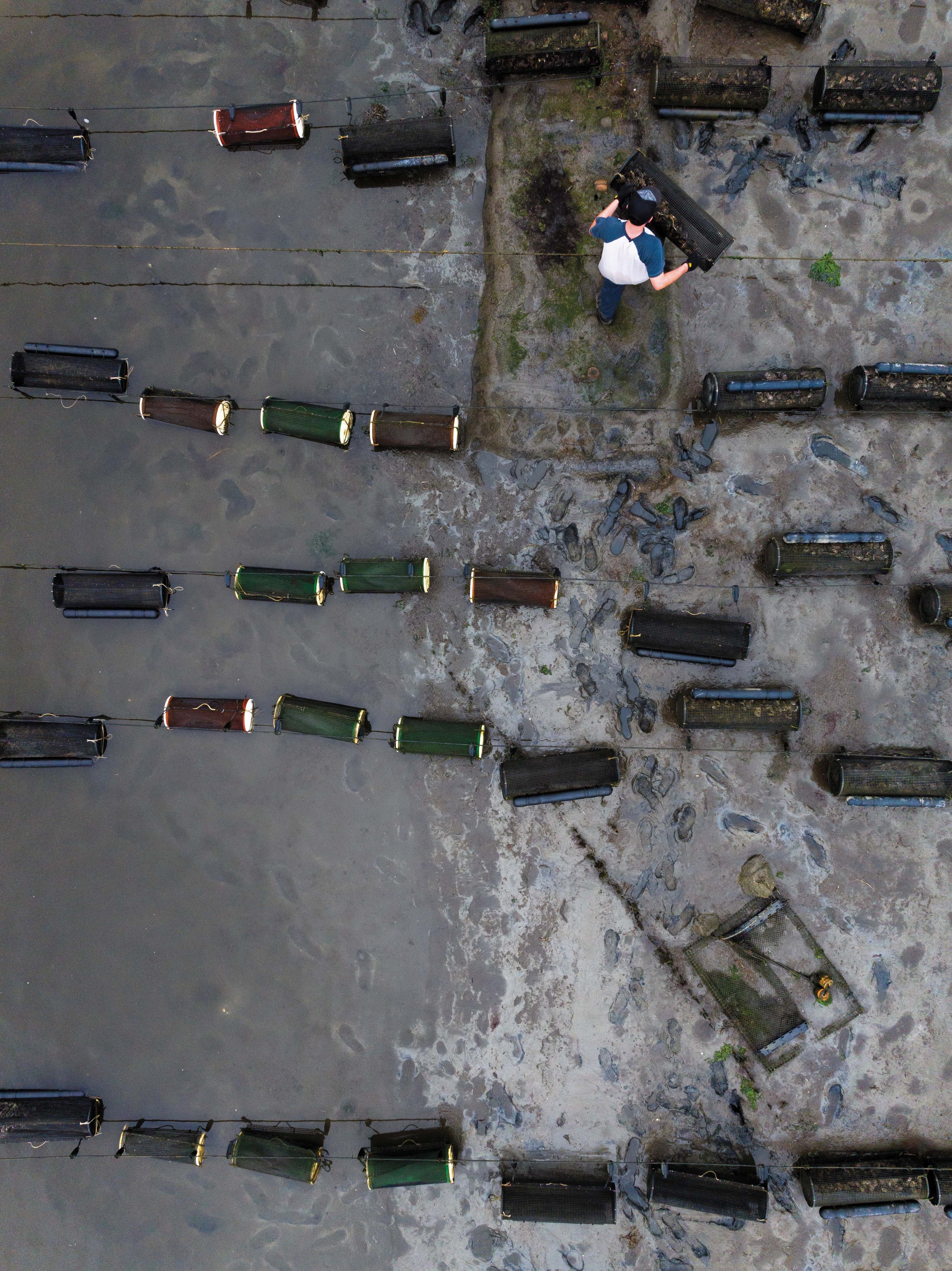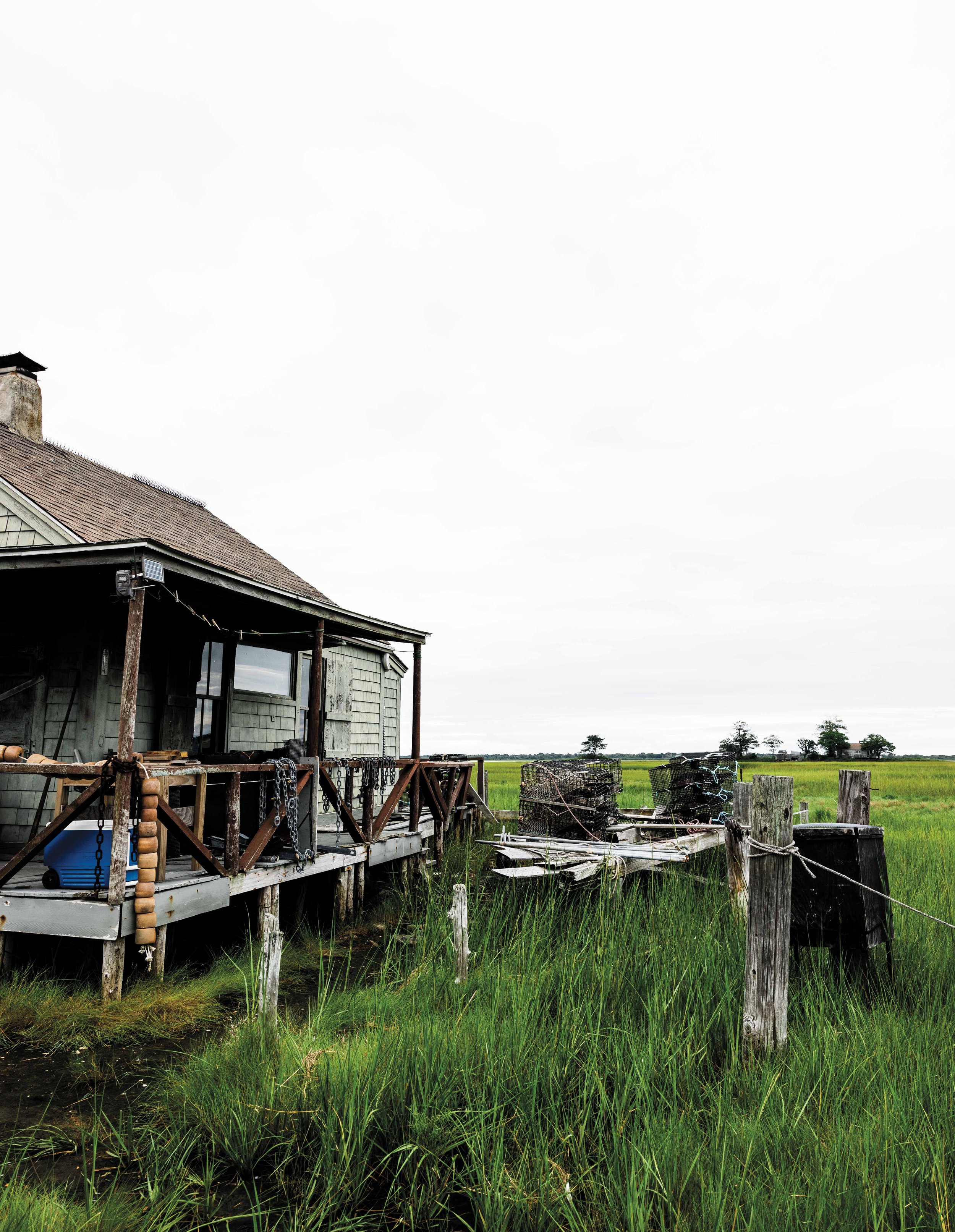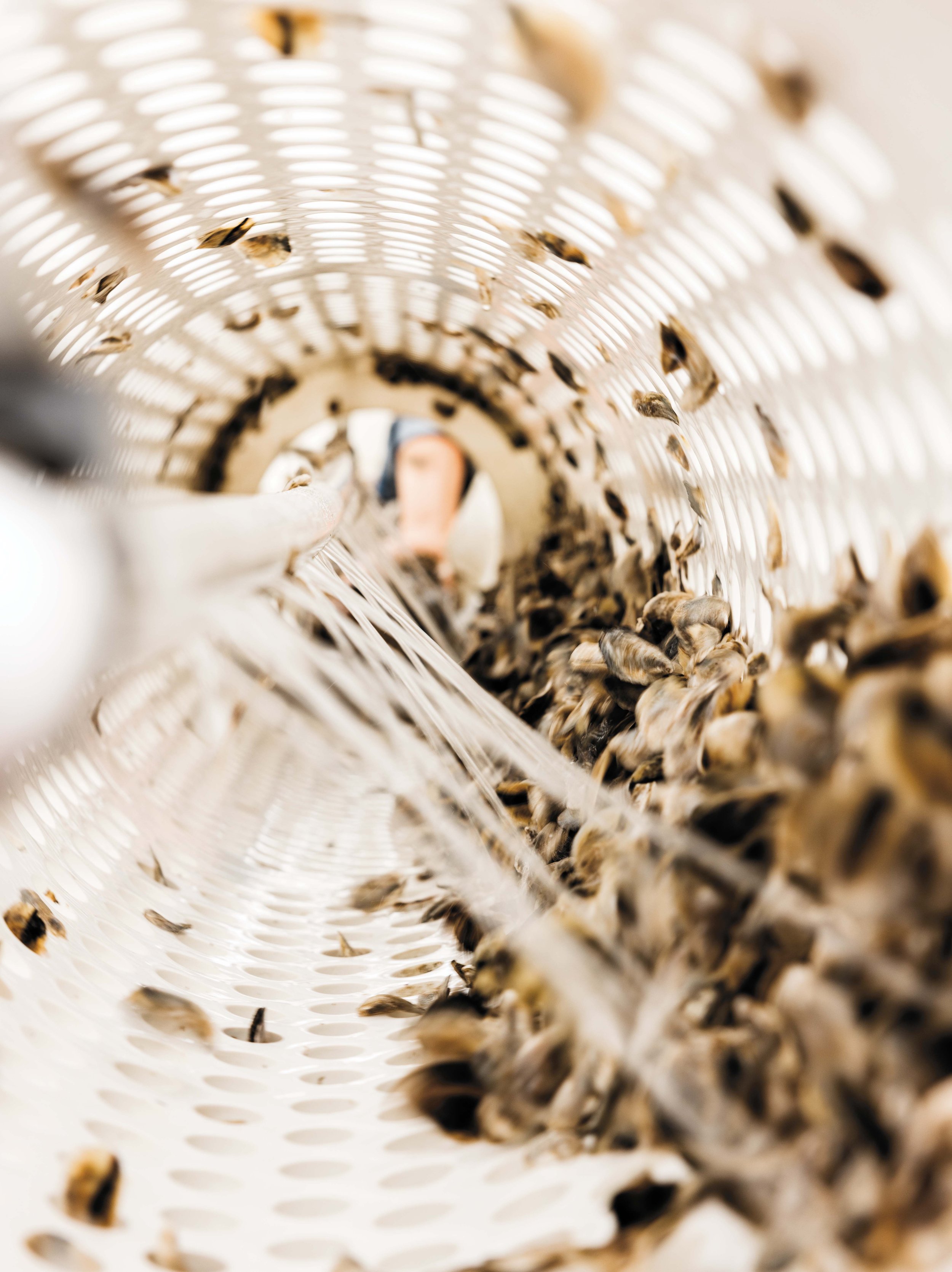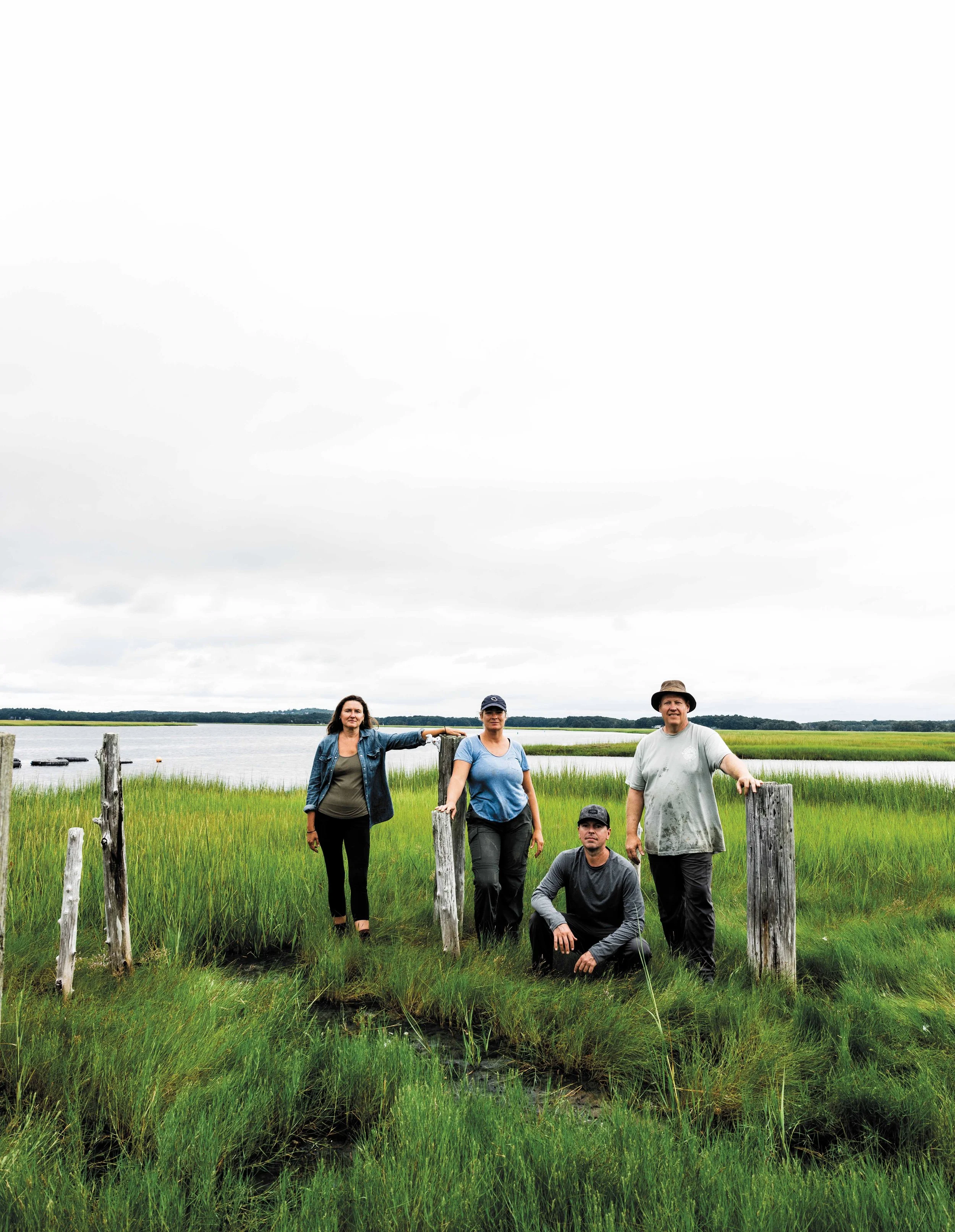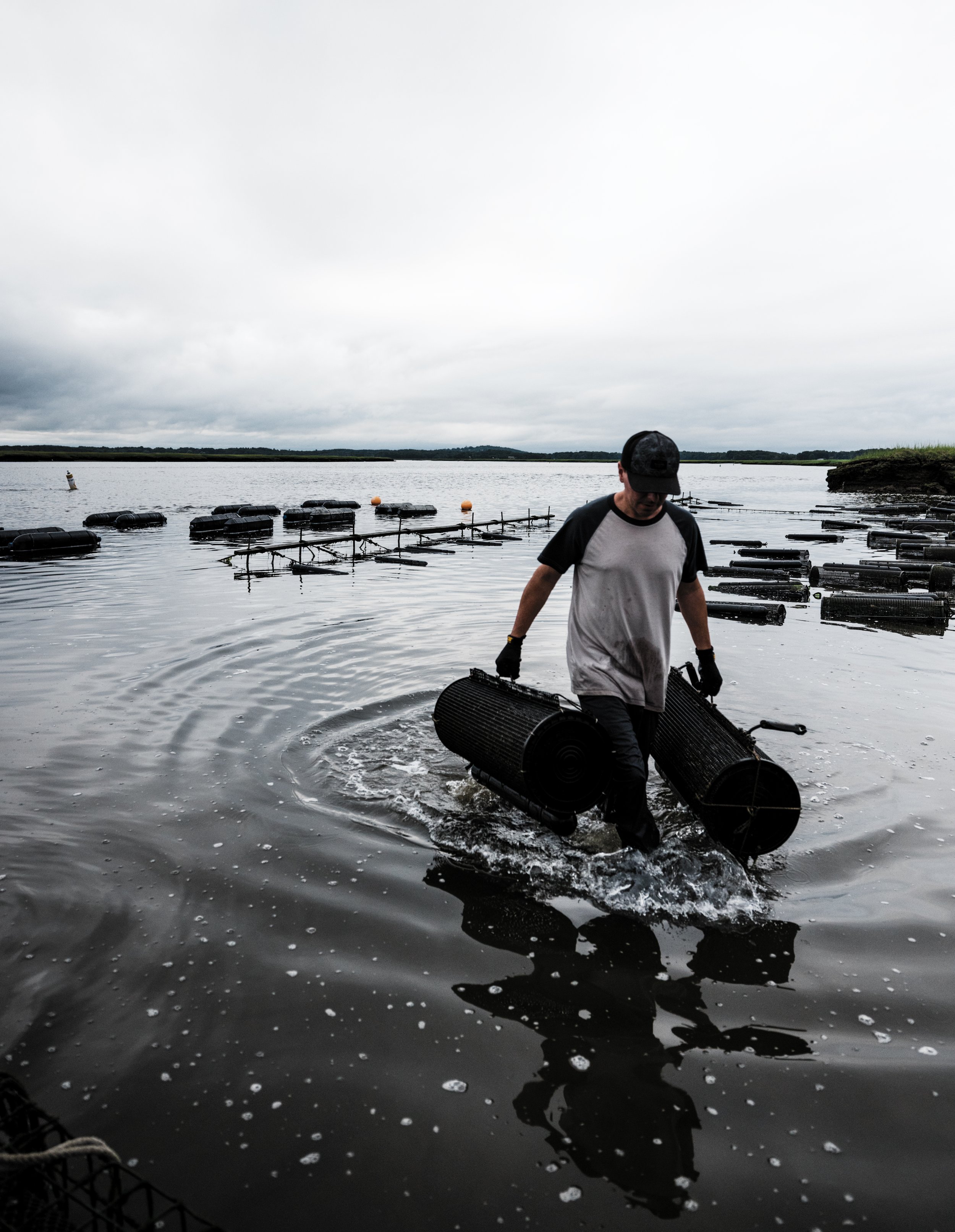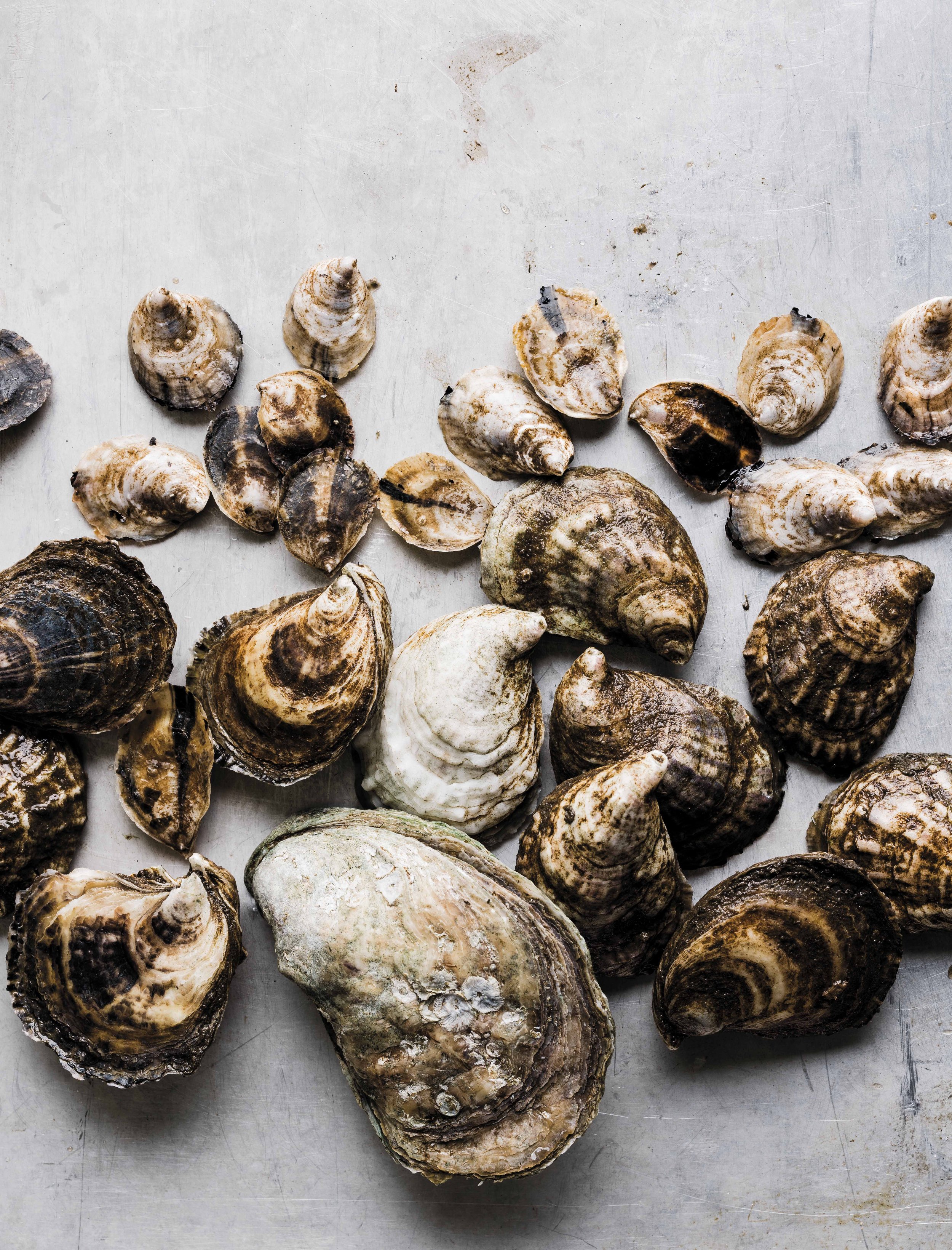Great Marsh Shellfish Company
Photos by Michael Piazza
The sky, water and sand are all the same moody shade of gray as we cut east along the Rowley River through the largest contiguous salt marsh in New England toward the mouth of Plum Island Sound on the North Shore. A whiff of the cool air smells like salt hay with a touch of tidal funk; the marsh grass all around us is a vivid green against the clouds. Small, weathered hunting and fishing camps perched on stilts dot the horizon, and we’re heading toward one in particular, built in 1902 and located at Zero Hog Island, site of The Great Marsh Shellfish Company, this area’s only operating aquaculture farm.
I’m with owner Brenden Doyle and his business manager, Lindsey Wishart. Doyle purchased this four-acre piece of property in the Great Marsh, complete with its own weathered former hunting and fishing camp, after seeing it for sale on Zillow in 2017. A former Naval submariner from a fishing family in Gloucester, Doyle and his dad had talked for years about trying to jumpstart the aquaculture industry on the North Shore. After his father died in 2002, Doyle set the project aside and focused on his dual careers in IT and property management. But his love of the water and his desire to be his own boss stuck with him.
In the past two decades, demand for shellfish—particularly oysters—has grown in Massachusetts and the U.S. overall, with national per capita consumption of shellfish on a progressive incline since the late 1990s, according to data from the National Oceanic and Atmospheric Administration (NOAA). A 2021 EPA report cited that 50 million farm-raised oysters were harvested in Massachusetts alone in 2019, representing a value of approximately $30 million for the Massachusetts oyster aquaculture industry.
WHY SO FEW SHELLFISH FARMS?
This growth has happened almost exclusively in the Southern part of the state, with farms clustered on the South Shore, South Coast and the Cape and Islands. On the North Shore, despite the 25,500-acre Great Marsh with its multiple tidal rivers emptying into Plum Island Sound and iconic mud flats that support a robust wild clamming industry, Doyle’s is the only farm currently operating.
Part of the reason is water quality, according to a Division of Marine Fisheries (DMF) official. DMF oversees the state’s commercial and recreational fisheries as well as certain aspects of marine aquaculture. Monitoring and classifying water quality is part of that. Closer proximity to Deer Island—Boston’s wastewater treatment plant—creates a buffer zone up into the North Shore. Closer to the Great Marsh, there are still point source pollution issues.
“The water quality that’s suitable for growing oysters is very important and limited,” says Joe Buttner, biology professor emeritus and aquaculture specialist at Salem State University. “The resources aren’t there to keep close enough tabs on the water.”
The hurdles in the permitting process itself limits the number of shellfish farms in this part of the state, too. The permitting process for shellfish farming is arduous—it took Doyle three and a half years to complete his permits and start farming—and requires town, state and federal agencies to sign off. According to Travis Kneeland, Rowley’s shellfish constable, “there’s plenty of interest, but when people start going through the process, they see there’s so much paperwork and the state has huge requirements [for potential farms].”
The first layer of approval comes from the town—without town approval, aquaculture won’t happen. “It all comes down to the selectmen, if they want to approve it or not,” says Kneeland. And the selectmen, says Doyle, often defer to the constable. In towns like Rowley, Ipswich and Essex, it’s a question of resources, considering the attention required for the commercial clamming industry here (valued statewide at $6.2 million in 2018). Monitoring clamming takes the bulk of the constables’ resources, says Kneeland. If the town greenlights your farm, you move on to the state, which has stringent requirements not just for water quality but for whether the site will interfere with public access or disturb the surrounding ecosystem—which in the Great Marsh is a delicate one.
“It’s a difficult game,” says Doyle. “I knew it wasn’t going to be easy when I got started with it.” (He attributes his success in navigating the permitting process to “sisu,” a Finnish term that roughly translates to intense perseverance in the face of a task that others might find insurmountable.)
TASTING A SENSE OF PLACE
Osprey glide overhead while I stand calf-deep in the mud at the edge of Doyle’s farm as we survey his operation. Rows of cages, each lashed to two pontoons, float about six feet off the river bottom. By definition, the floating cages are a subtidal operation—always submerged—as opposed to an intertidal setup where cages sit on the bottom and are submerged and exposed according to tidal flow. Waist-high in the water, Wishart flips the cages as part of the tumbling process; this helps the mollusks develop the deep, rounded cups sought out by oyster lovers.
Doyle hands me a bull rake used for clam digging and shows how to cut into the soft sand anywhere you see the telltale bubbling hole where a clam might be. My rake comes up full of rocks. But Doyle pulls up a wild river oyster and shucks it for me. It’s fat, with a smooth brininess and a grassy sweetness toward the end, a platonic ideal of an oyster.
It’s this profile Doyle is chasing. Growing oysters in a tidal river—as opposed to bays where most other Massachusetts oysters are raised—means they’ll have more of that hay-like grassiness, Wishart explains. With direct access to the ocean via Plum Island Sound to their east, the tide flowing in and out twice daily gives Great Marsh’s oysters the strong flavor of the ocean up front, she says. “In the back, there’s a sweetness.” She pauses for a minute. We watch barn swallows perch on a nearby piling. “I don’t know if this is appealing to everyone but when you’re out here a lot and you have an appreciation of place, that taste of the salt marsh is awesome.”
Doyle will have to keep summoning his sisu as he builds his business. The Great Marsh is designated an Area of Critical Environmental Concern (ACEC), which means it’s hard to get a permit to make improvements to the farm’s infrastructure, like the dock or the camp. Heavy rains like the ones we saw in the spring and early summer trigger automatic closures of shellfish beds between four and eight days, depending on the amount of rainfall. Warming water temperatures can cause the Vibrio bacteria to bloom, which can also lead to closures of the shellfish beds.
Despite the challenges, it’s not hard to see why Doyle persists. In a peaceful, beautiful setting, he works on what he calls “tide time,” and gets to quite literally muck around while figuring out his business—how to grow the oysters to just the right size and shape; when to add clams, mussels and even kelp to the mix; how to best protect his oysters from vandalism or predators like green crabs. “We don’t have this down,” he says. “It’s a constant learning process.”
Hopefully, his success will open the doors for other aquaculture operations to follow on the North Shore. Says Buttner, the Salem State biologist, “I think oysters on the North Shore deserve careful consideration, and [Doyle] is doing us a service.”

